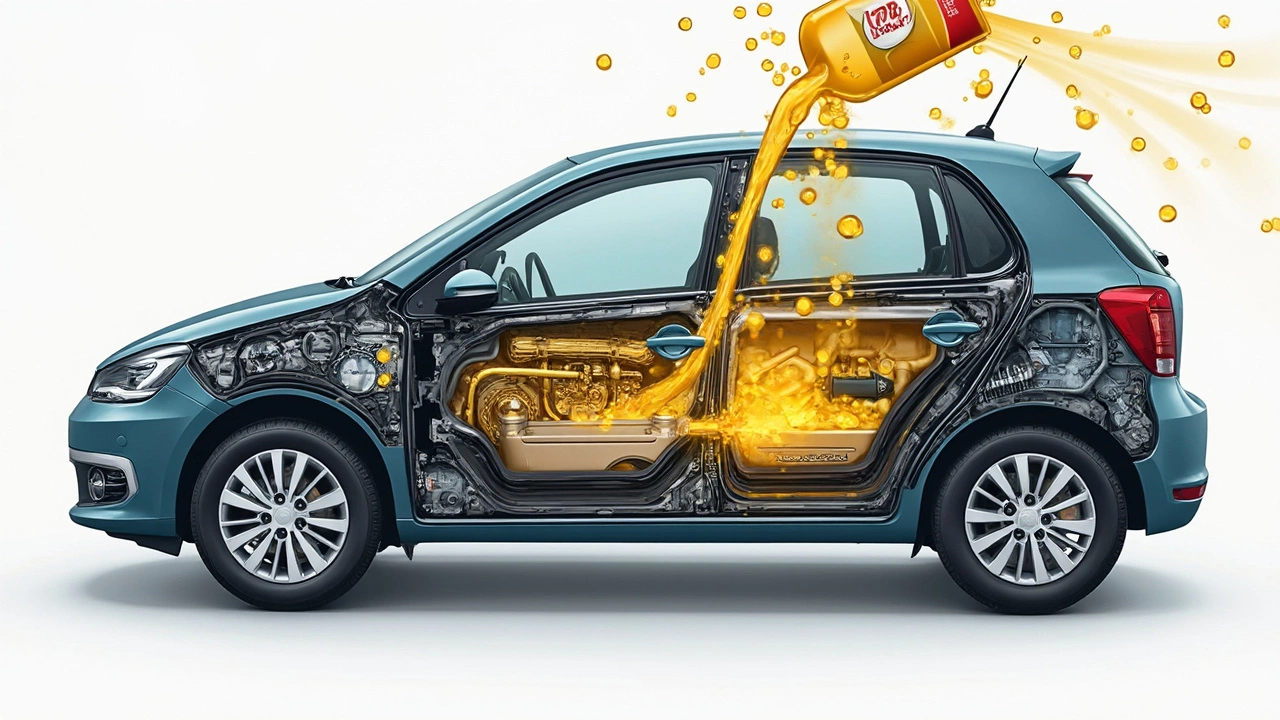Add a little fresh oil to your car without draining the old stuff—every driver has done it. Maybe the oil light pops on, or you check the dipstick and realize you’re running low. It’s a quick fix when you’re busy or far from a garage. But is it really safe for your engine in the long run?
Mixing new oil with old oil won’t wreck the engine right away. Fresh oil actually helps by boosting the overall lubrication and replacing what’s been burned off or broken down. Your engine keeps running smoothly, and you avoid the risk of running low, which can cause way bigger problems.
But here’s the thing: topping up is not the same as changing your oil. Old oil collects dirt, metal shavings, and fuel residue, turning it sludgy over time. New oil helps, but it can’t magically clean out the gunk that’s already settled in. If you’re always just topping off and never doing a full oil change, you’re letting all that grime build up, which can shorten the life of your engine.
There are times when adding new oil is exactly what you should do—like on a road trip when you notice the level is low. Just don’t make it a habit to skip full oil changes. You want your engine running like new as long as possible, and that only happens when you get rid of the old, dirty oil regularly.
- What Happens When You Mix Old and New Oil?
- Is Topping Up Oil Safe for the Engine?
- When Is It Time for a Full Oil Change?
- Signs Your Oil Needs Attention
- Common Mistakes People Make
- Pro Tips for Healthy Engine Oil
What Happens When You Mix Old and New Oil?
When you pour new oil into an engine that still has old oil, the two blend together right away. Both types of oil mix inside the crankcase and flow through all those small engine passages. Contrary to what some people think, nothing catastrophic happens on the spot. You’re not going to ruin your engine with a top-off. New oil can slightly improve lubrication and help keep things moving, especially if your oil level was low.
But let’s be real—adding new oil doesn’t make dirty oil clean. The old oil still contains things like burnt additives, bits of metal, and carbon. Over time, these contaminants can gum up engine parts and speed up wear and tear. A study from the American Petroleum Institute found that after just 5,000 miles, oil’s detergent properties are noticeably weaker. That means the oil gets worse at holding on to junk that can harm your engine.
“Mixing fresh oil with used oil will not rejuvenate the used oil or restore its original properties,” says the Car Care Council. “It will dilute the effects of old oil, but the engine still needs fresh oil to stay clean and healthy.”
Here’s a quick look at what’s happening inside your engine when you mix them up:
- Engine oil level rises, which helps prevent overheating.
- The total mix gets thinned out, but the old contaminants aren’t removed.
- Old sludge and grit just keep building up unless you drain everything out.
If you’re wondering how quickly oil degrades, check out how oil quality drops off by mileage in this table:
| Miles Driven | Oil Condition | Additive Strength |
|---|---|---|
| 1,000 | Mostly clean | 90-100% |
| 3,000 | Starting to darken | 70-80% |
| 5,000 | Dirty, less slick | 50-60% |
| 7,500+ | Very dirty, sludge risk | Below 40% |
So, mixing new and old oil keeps the engine going when you’re in a pinch, but it’s never a substitute for a regular oil change. You’re just buying yourself a little time, not a brand-new engine.
Is Topping Up Oil Safe for the Engine?
If you’re low on engine oil, topping up is almost always better than driving around with not enough oil. Your engine needs a certain amount of oil to keep all the moving parts lubricated. When the oil drops below the minimum on your dipstick, things start to heat up and metal parts rub together. That’s when you can get expensive damage, even complete engine failure.
Topping up now and then is perfectly safe—if your engine just burns a bit of oil between changes, you’re not hurting anything. Actually, a lot of cars, especially older models and some turbo engines, use a little oil as part of normal operation. That’s why manufacturer handbooks actually mention checking and topping up oil between changes.
But there’s a big difference between topping off occasionally and trying to get by without ever changing your oil. Fresh oil added to dirty, old oil helps a bit with lubrication, but it can’t get rid of old, broken-down additives or the junk that builds up. So, think of topping up as a short-term fix when you’re between oil changes—not a replacement for proper maintenance.
Want a quick look at what topping up and changing your oil actually mean for your engine? Here’s a simple breakdown:
| Action | When to Do It | Effect on Engine |
|---|---|---|
| Topping Up Oil | When oil level is low but oil is still in good shape | Keeps lubrication steady and avoids engine stress |
| Full Oil Change | When oil is dirty, dark, or at the mileage limit | Flushes out contamination and restores protection |
If you notice your car needing frequent top-ups (say, more than every 1,000 miles), that’s a sign something’s not right—could be a leak or your engine burning oil. Don’t ignore it; a mechanic can help spot the problem before it gets ugly.
- Always check oil right after the engine’s had a chance to cool down for a few minutes.
- Use the exact oil grade recommended by your car’s manufacturer. Mixing brands isn’t a big deal, but grades and specs matter.
- Don’t let the oil level sit above the max line. Too much oil can hurt the engine just as much as too little.
It’s all about balance—top up when you need to, but don’t ditch your regular oil change schedule. That’s the simplest way to keep your engine running strong for the long haul.
When Is It Time for a Full Oil Change?
You can’t just throw new engine oil on top forever and hope for the best. Even if you keep topping up, the old oil gets thicker, grimier, and stops doing its job well. Skipping real oil changes leads to more wear inside your engine and could mean big repair bills down the line. So, when should you bite the bullet and do a full oil change?
The answer depends on how much you drive, the kind of driving you do, and what your car’s manufacturer recommends. Back in the day, most folks changed oil every 3,000 miles, but now, with modern engines and synthetics, intervals have stretched a lot. Many cars can run 5,000 to 7,500 miles before needing a change. Some even go up to 10,000 miles, but that’s usually for newer vehicles with synthetic oil and gentle driving.
| Driving Condition | Recommended Oil Change Interval |
|---|---|
| Regular daily driving (synthetic oil) | 5,000 – 7,500 miles |
| Frequent short trips, stop-and-go urban driving | 3,000 – 5,000 miles |
| Heavy towing or extreme hot/cold weather | Even sooner (check manual!) |
| Older cars (non-synthetic oil) | 3,000 miles |
Most cars nowadays have an oil life monitor, which takes the guesswork out. If your dashboard says it’s time, don’t ignore it. And always check the owner’s manual. Car makers spend millions figuring out the best schedule for every model, so you really can’t go wrong by following their advice.
If you notice that your oil looks black and grimy, or it smells burnt, it’s also time. You might spot a decrease in fuel efficiency or hear extra engine noise when things get really overdue. The golden rule: regularly changing the engine oil will save you money in the long run, and your engine will thank you for it.
- Always use the oil type and grade your car maker recommends.
- Keep a record or set reminders in your phone—the sticker on the windshield isn’t just for show.
- Oil changes are quick and cheaper than engine repairs. Don’t stretch it further than you have to.

Signs Your Oil Needs Attention
You don't need to be a mechanic to spot when your engine oil is due for a check. Let’s go over the warning signs you shouldn’t ignore, because catching these early can save your engine from serious trouble.
- Engine oil warning light: This is the most obvious sign. When the oil light flicks on, it means your oil level is low or the oil pressure has dropped. Ignoring it could lead to engine damage – don’t risk it.
- Strange engine noises: If your engine starts tapping, knocking, or just sounds rough, old or low oil might not be lubricating things right. That extra noise is metal rubbing on metal, which is never good news.
- Oil looks dirty or gritty: Fresh oil is amber and see-through. If you pull out the dipstick and find thick, dark, or muddy oil, it’s probably overdue for a change. Dirt and metal particles in the oil can grind down engine parts.
- Oil level keeps dropping: If you have to keep topping up your oil, you could have a leak or your engine is burning more oil than it should. Either way, it’s time to look closer.
- Burning oil smell or smoke: Smelling burnt oil or seeing blue smoke from the exhaust often means oil is leaking onto hot engine parts. That stuff is flammable, and you shouldn’t wait to check it out.
Gabe Shenhar, a senior auto test engineer for Consumer Reports, put it clearly:
"Checking your oil is the easiest way to extend the life of your engine. You don’t have to change it every time you check, but ignoring the warning signs will cost you.”
If you notice any of these signs, don’t just add more oil and hope for the best. Take a couple minutes to look at what’s going on or get help from a pro. Your car’s health depends on it.
Common Mistakes People Make
It’s way too easy to mess up when dealing with engine oil, especially if you’re in a hurry or haven’t checked your manual. Plenty of drivers, even experienced ones, fall into the same traps again and again. The good news? You can dodge most of these mistakes just by knowing what to watch for.
First up, a lot of people just keep topping off their oil, thinking it’s basically the same as getting a full oil change. The truth is, it’s not. Topping up only adds more oil to dirty oil—it doesn’t get rid of the goop and crud lurking at the bottom of your oil pan. Over time, all that grime can mess with your engine’s moving parts.
Some folks ignore the type or grade of oil their car actually needs. Your mechanic and the owner’s manual aren’t just being fussy here! Using the wrong viscosity or rating can reduce protection, hurt fuel economy, and sometimes even void a new car warranty. A 2022 Consumer Reports survey called using the right oil 'critical to engine health and long-term reliability.'
“Failing to use the recommended oil type can actually do more harm than skipping an oil change by a few hundred miles,” – Consumer Reports Auto Team
Another classic blunder: forgetting to check oil levels often enough. Engines can burn or leak oil without you noticing, and if you’re only adding oil once things are really low, you risk engine wear or, in worst cases, total engine failure.
- Using cheap filters instead of good-quality ones. A poor filter can let dirt cycle through your engine again and again.
- Pouring in too much oil. Overfilling can cause just as many issues as running low—think frothy oil and poor lubrication.
- Ignoring oil change intervals. Stretching time between changes saves a buck today but might cost thousands in repairs later.
And don’t forget, “dark oil” doesn’t always mean bad oil. Diesel engines turn oil dark fast. Instead, go by miles driven or what your dashboard tells you—not just the color of the oil.
Pro Tips for Healthy Engine Oil
Want your car engine to last and avoid those avoidable breakdowns? Taking good care of your engine oil is where it all starts. Most cars can run well over 150,000 miles if you just follow a few key oil tips. Let’s get straight to what works in real life.
- Stick to the schedule: Always follow your owner’s manual for oil change intervals. For most newer cars, that’s every 5,000 to 7,500 miles. Older cars and severe driving—think lots of short trips or stop-and-go traffic—might need changes every 3,000-5,000 miles.
- Check oil level monthly: Pop the hood at least once a month and check the dipstick. Top up if you’re low, but remember that regular drops can signal leaks or burning.
- Use the right oil type and grade: There are all sorts of oils—synthetic, semi-synthetic, conventional. Your car’s manual lists exactly what the engine needs. Using the wrong oil can mean weaker lubrication and more engine wear.
- Change the oil filter every time: Don’t cheap out and skip the filter. A clogged filter keeps dirty oil flowing, and you want fresh oil to run through a clean filter.
- Keep an eye on oil color and smell: Fresh oil looks amber and clear. If it turns black or smells burnt, swap it out—even if you’re not due for a change.
- Don’t mix oil brands too much: While it’s safe in a pinch, constantly pouring in different brands or types can mess with additives. Stick with one trusted brand if you can.
Here's a quick look at common oil change myths versus reality:
| Myth | Reality |
|---|---|
| Oil must be changed every 3,000 miles no matter what | Many modern cars can go 5,000-7,500 miles with no problem |
| Synthetic oil causes leaks in older engines | Synthetic oil is usually fine and can actually reduce sludge in older engines |
| Dark oil always means dirty oil | Oil changes color as it works. Rely more on smell or texture than color alone |
Last tip—don’t ignore oil warning lights. If that dashboard symbol pops up, it means your engine wants attention now, not next weekend. Get it checked right away to avoid major headaches (and bills) down the road.

